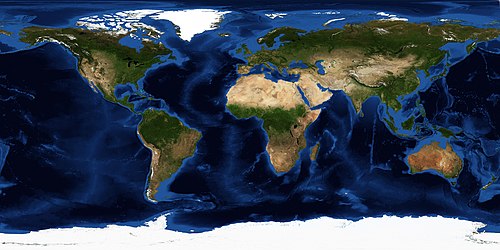Explorers Grand Slam
Location of the expedition goals, highlighting the Three Poles Challenge
|
The Explorers Grand Slam (also Adventurers Grand Slam ) is an alpine challenge for adventurers and extreme sports enthusiasts , which usually consists of climbing the Seven Summits and reaching the North and South Poles on their own. The combination of reaching the two poles and climbing Mount Everest is also known as the Three Poles Challenge .
definition
There is no general definition of the term “Explorers Grand Slam”. The consensus in adventure and mountaineering circles is climbing the highest peaks of all seven continents ( Seven Summits ) and reaching the northernmost and southernmost points on earth. Ryan Waters tried unsuccessfully to standardize the Grand Slam, which neither the Royal Geographical Society nor the exclusive Explorers Club have made to this day. A problem is also non-subject media, which are more interested in human interest stories than in real research and lump all kinds of Grand Slams together.
At times, there is mainly disagreement about how the two poles should be reached. Vanessa O'Brien , Fellow of the Royal Geographical Society and a 2013 Grand Slam graduate, therefore introduced the minimum requirement for an expedition start at 89 ° latitude ( last degree ), which corresponds to a distance of around 111 km to the North or South Pole. On her website she lists 63 people who have successfully completed the challenge.
history
Before anyone thought of introducing an Explorers Grand Slam, the American Dick Bass came up with the idea of climbing the Seven Summits in the early 1980s. In 1983 and 1985 he was the first person to do this. Reinhold Messner later suggested that instead of Mount Kosciuszko, the Carstensz pyramid should be viewed as the highest peak in Australia .
Three Poles Challenge
The first person who was demonstrably able to reach all three “poles”, in addition to the northernmost and southernmost point on earth, on his own, was the Norwegian Erling Kagge . After reaching the North Pole in 1990 and the South Pole in 1993 on skis, he climbed Mount Everest on May 8, 1994 . He later also completed the Explorers Grand Slam.
Milestones and Records
The Guinness Book of Records lists the Briton David Hempleman-Adams as the first mountaineer to complete the “Adventurers Grand Slam”. In 1980, Hempleman-Adams climbed North America's highest mountain, Mount McKinley, and completed the Grand Slam in May 1998, accompanied by Rune Gjeldnes , with an expedition to the North Pole. He also visited both magnetic poles .
The South Korean Park Young-seok mastered a special kind of Grand Slam , who climbed all 14 eight-thousanders in addition to the Seven Summits and the Three Poles Challenge . Its first summit was Mount Everest in 1993 and finally reached the North Pole in April 2005. The Guinness Book simply calls this achievement the “Explorers Grand Slam”, whereas Vanessa O'Brien speaks of a “ True Explorers Grand Slam”. So far only the Chinese Zhang Liang has been able to repeat this feat, but this is considered controversial due to an unclear length of his North Pole expedition.
In 2011, the former Welsh rugby player Richard Parks was the first person to complete the Grand Slam within a year - it took him just under seven months. The Chinese Wang Jing completed the 2014 Challenge within 142 days, and the American Colin O'Brady was three days faster in 2016. The youngest graduate in April 2017 was the Japanese Marin Minamiya at the age of 20 years and 114 days. Julia Schultz was the first German to complete the Explorers Grand Slam in May 2017.
Under the project name Adaptive Grand Slam , a group of leg- and arm amputated set climbers aim first complete the Grand Slam as Para athletes to deal with.
Well-known graduates
- David Hempleman-Adams (1980-1998)
- Erling Kagge
- Fyodor Konyukhov
- Park Young-seok (1993-2005)
- Richard Parks (2011)
- Vanessa O'Brien (2012-2013)
- Wang Jing (2014)
- Colin O'Brady (2016)
- Victor Vescovo
Web links
Individual evidence
- ↑ a b Alex van den Broek: Can the Explorer's Grand Slam Be Saved? Explorers Web, August 22, 2018, accessed January 17, 2019 .
- ↑ Vanessa O'Brien, FRGS : Explorers Grand Slam. Retrieved January 17, 2019 .
- ↑ a b c d Explorers Grand Slam. Vanessa O'Brien, accessed January 17, 2019 .
- ^ First person to complete the Three Poles Challenge. Guinness World Records , accessed January 17, 2019 .
- ^ First person to complete the Adventurers Grand Slam. Guinness World Records , accessed January 17, 2019 .
- ^ First person to complete the Explorers' Grand Slam. Guinness World Records , accessed January 17, 2019 .
- ↑ Fastest time to complete the climb the Seven Summits and ski the polar last degrees (male). Guinness World Records , accessed January 16, 2019 .
- ^ Youngest person to climb the Seven Summits and ski the polar last degrees. Guinness World Records , accessed January 17, 2019 .
- ↑ Michael Munkler: On the highest peak of all continents. In: Allgäuer Zeitung , local section Füssen , edition of February 22, 2018.
- ↑ 7 peaks. 7 continents. 2 poles. 1 mission. Adaptive Grand Slam, accessed January 17, 2019 .


